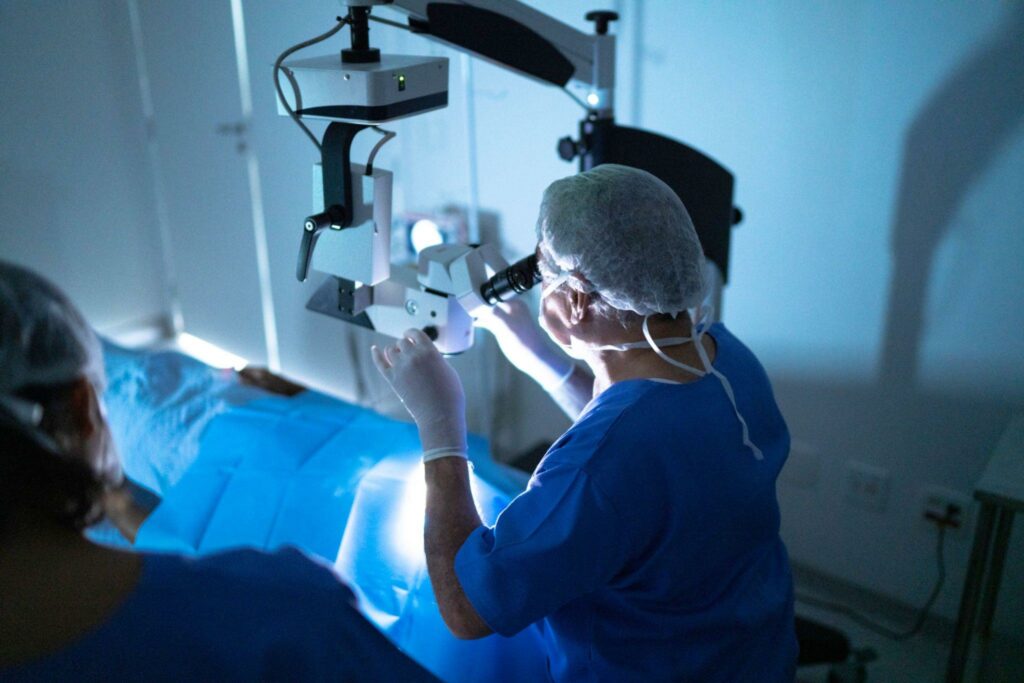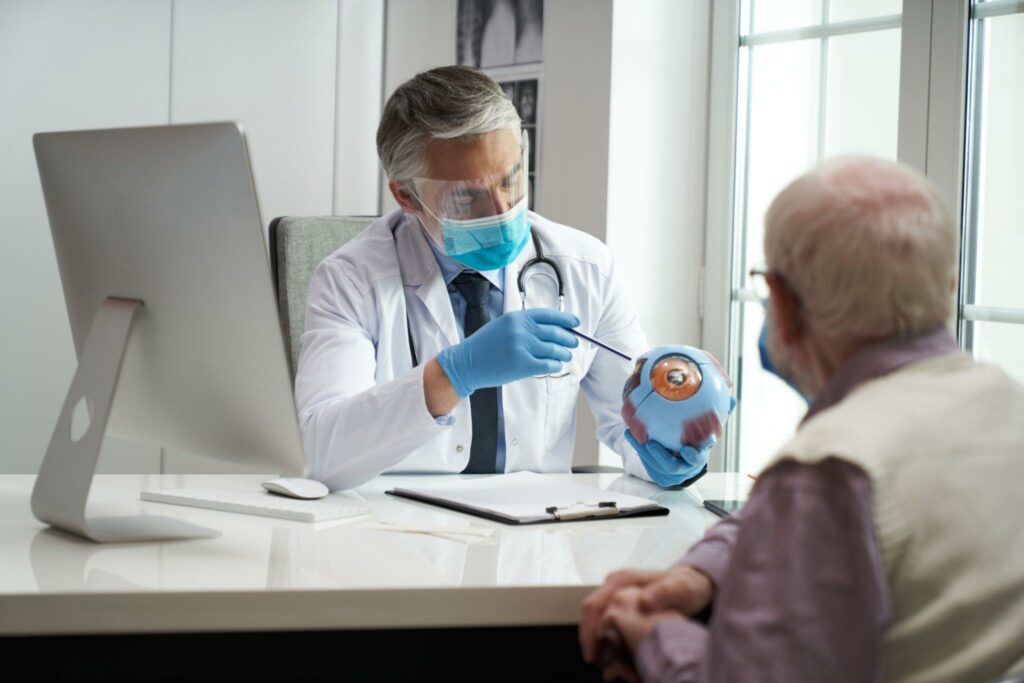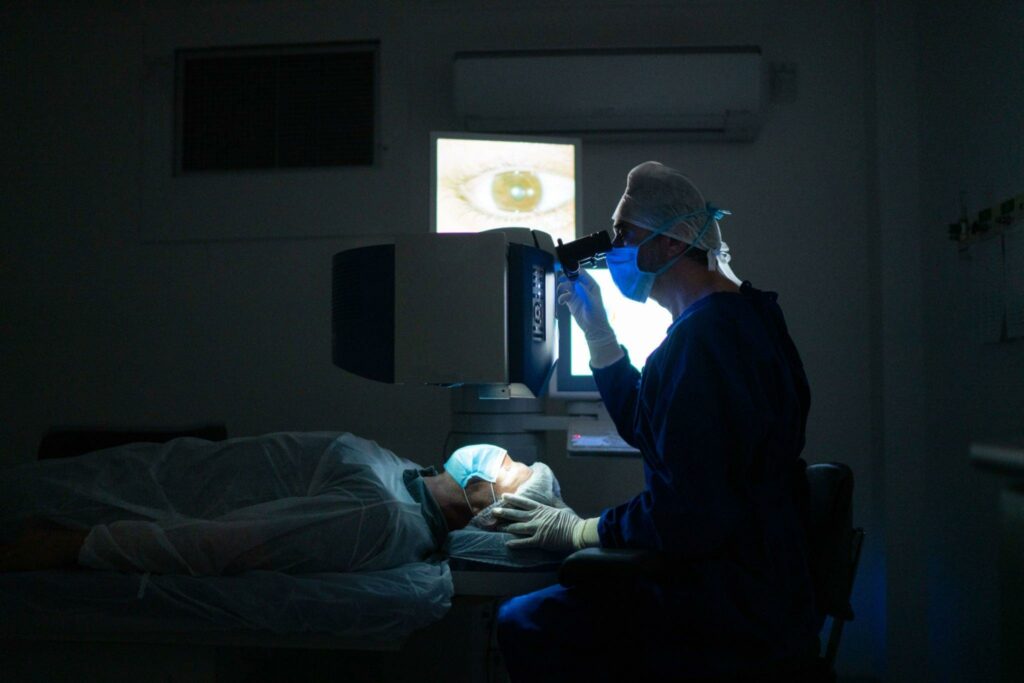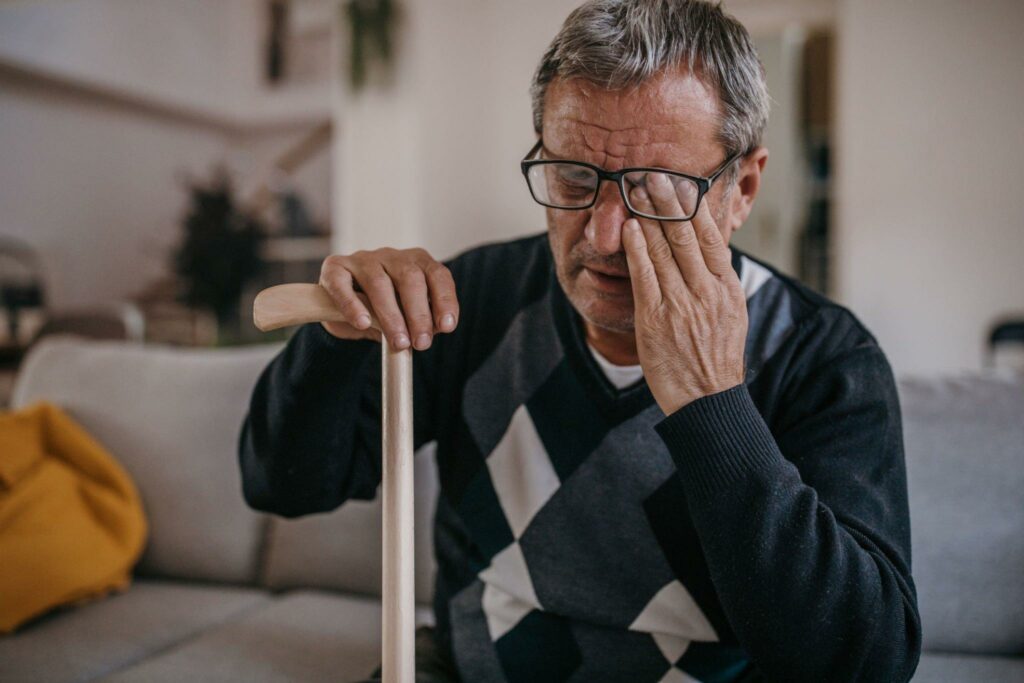Diabetes can affect the retina, the thin layer of tissue at the back of the eye that is responsible for sending visual signals to the brain. The retina contains small blood vessels that can become damaged by high levels of blood sugar over time. There are two main ways that diabetes can affect the retina:
- Diabetic retinopathy: This is a condition that occurs when the blood vessels in the retina become damaged, either by leaking fluid or by growing abnormally. Diabetic retinopathy is the most common cause of vision loss in individuals with diabetes. Over time, the damage to the blood vessels can cause scar tissue to form, which can lead to retinal detachment and permanent vision loss.
- Diabetic macular edema (DME): This is a specific type of diabetic retinopathy that occurs when fluid accumulates in the macula, the central part of the retina responsible for sharp, detailed vision. DME can cause the macula to swell, which can distort or blur vision.
Both diabetic retinopathy and DME can develop gradually over time, often without any noticeable symptoms until the damage is significant. It is important for individuals with diabetes to have regular eye exams to detect any signs of retinal damage early and to prevent vision loss. Laser treatment is a commonly used method to manage diabetic retinopathy and prevent further vision loss.
Who is at risk for developing diabetic retinopathy?
Anyone with diabetes can develop diabetic retinopathy, but the risk increases the longer someone has had diabetes and the less well-controlled their blood sugar levels are. Other risk factors for diabetic retinopathy include:
Type of diabetes
Individuals with type 1 diabetes are at a higher risk of developing diabetic retinopathy, as are those with type 2 diabetes who have had the condition for a long time.
High blood sugar
Elevated blood sugar levels can damage the blood vessels in the retina over time.
High blood pressure
Uncontrolled high blood pressure can increase the risk of developing diabetic retinopathy.
High cholesterol
High levels of cholesterol and triglycerides in the blood can increase the risk of retinal damage.
Pregnancy
Women with diabetes who become pregnant are at an increased risk of developing diabetic retinopathy.
Smoking
Smoking can increase the risk of developing diabetic retinopathy and make the condition worse if it does develop.
Genetics
Some people may be more genetically susceptible to developing diabetic retinopathy.
Laser treatment for diabetic retinopathy
Laser treatment for diabetic retinopathy is usually performed in an outpatient setting and involves the use of a laser to target and seal off damaged blood vessels in the retina. There are two types of laser treatment commonly used for diabetic retinopathy:
- Focal laser treatment: This type of laser treatment is used to treat specific areas of the retina where blood vessels have started to leak. The laser is used to seal off the leaking blood vessels, which can help prevent further damage to the retina.
- Panretinal photocoagulation (PRP): PRP is used to treat more widespread damage to the retina, such as when abnormal blood vessels begin to grow. The laser is used to create hundreds of small burns in the retina, which can help to reduce the growth of new blood vessels.
Both types of laser treatment for diabetic retinopathy are considered safe and effective, but there can be some side effects. These may include temporary blurring of vision, sensitivity to light, and a feeling of pressure in the eyes. In some cases, patients may need more than one laser treatment session to manage their condition effectively.
In addition to these two main types, there are also other laser treatments that may be used for diabetic retinopathy in certain cases. These include:
- Subthreshold laser treatment: This is a type of laser treatment that uses lower levels of laser energy than other treatments. It is used to reduce inflammation and improve blood flow in the retina.
- Pattern scanning laser treatment: This type of laser treatment uses a computer-guided laser to target damaged areas of the retina with greater precision, potentially reducing the risk of damage to healthy tissue.
- Combination laser treatment: In some cases, a combination of focal laser treatment and PRP may be used to manage diabetic retinopathy. This can help to target both specific areas of damage and more widespread problems in the retina.
Overall, the type of laser treatment used for diabetic retinopathy will depend on the individual’s specific condition and the extent of damage to the retina. A healthcare professional can help determine the most appropriate treatment plan.
When is Laser Treatment indicated?
Laser treatment for diabetic retinopathy may be needed in the following situations:
Macular edema
If there is swelling in the macula, which is the central part of the retina responsible for sharp, detailed vision, laser treatment may be recommended. The laser is used to reduce swelling and prevent further damage to the macula.
Proliferative diabetic retinopathy (PDR)
This is a more advanced form of diabetic retinopathy that occurs when abnormal blood vessels begin to grow in the retina. If left untreated, these blood vessels can leak and cause scar tissue to form, which can lead to vision loss. Laser treatment, typically panretinal photocoagulation (PRP), is used to reduce the growth of abnormal blood vessels and prevent further damage to the retina.
High-risk characteristics
Laser treatment may also be recommended for individuals who are at high risk of developing diabetic retinopathy or who have certain high-risk characteristics, such as severe non-proliferative diabetic retinopathy (NPDR), macular edema, or significant changes in blood vessels.
Overall, the decision to use laser treatment for diabetic retinopathy will depend on the individual’s specific condition and the extent of damage to the retina.
Laser treatment for diabetic retinopathy side effects
Laser treatment for diabetic retinopathy is generally considered safe and effective. However, like any medical procedure, there are some risks and side effects to consider. These may include:
Blurred vision
Following laser treatment, it is common to experience blurred vision, sensitivity to light, or a feeling of pressure in the eyes. These symptoms usually resolve within a few hours or days after treatment.
Reduced peripheral vision
Panretinal photocoagulation (PRP) may cause some reduction in peripheral vision, which can affect activities such as driving. This is usually a minor effect, but it is important to discuss any concerns with a healthcare professional.
Increased risk of cataracts
Over time, laser treatment for diabetic retinopathy may increase the risk of developing cataracts, a clouding of the lens in the eye. This is more common in individuals who have had multiple laser treatments.
Increased risk of glaucoma
PRP can also increase the risk of developing glaucoma, a condition that damages the optic nerve and can cause blindness if left untreated. Regular eye exams can help detect and manage any potential problems.
In rare cases, more serious side effects may occur, such as bleeding, infection, or retinal detachment. However, these are very rare.
It is important to discuss any potential risks or side effects with a healthcare professional before undergoing laser treatment for diabetic retinopathy. Regular follow-up appointments are also recommended to monitor the effectiveness of treatment and detect any potential complications.
What to expect before, during, and after laser surgery for diabetic retinopathy?
Before laser surgery for diabetic retinopathy:
Consultation
Before laser surgery, you will have a consultation with your eye doctor to discuss the procedure and any risks or side effects. You will also undergo a comprehensive eye exam to assess the extent of your retinopathy and determine the best course of treatment.
Preoperative testing
You may need to undergo additional testing to assess your general health and make sure you are a suitable candidate for laser surgery.
Medications
You may be prescribed eye drops or other medications to help prevent infection and reduce inflammation before and after the procedure.
During laser surgery for diabetic retinopathy:
Local anesthesia
The procedure is typically performed under local anesthesia, which means you will be awake but your eye will be numbed to prevent pain.
Laser treatment
During the procedure, a laser is used to create small burns on the retina to seal off leaking blood vessels or stop the growth of abnormal vessels.
Duration
The procedure usually takes around 15-30 minutes, depending on the extent of your retinopathy.
After laser surgery for diabetic retinopathy:
Diabetic retinopathy laser treatment recovery time
You can usually go home on the same day as the procedure, but you may need to rest for a few days to allow your eye to heal.
Medications
You may be prescribed eye drops or other medications to prevent infection and reduce inflammation.
Follow-up appointments
You will need to attend follow-up appointments with your eye doctor to monitor the progress of your retinopathy and ensure that the laser treatment was successful.
Vision changes
It is common to experience some blurring or distortion of the vision immediately after the procedure, but this usually improves within a few days or weeks. However, some patients may experience a permanent loss of peripheral vision or other visual changes.
It is important to follow all post-operative instructions carefully and attend all scheduled follow-up appointments to ensure the best possible outcome from laser surgery for diabetic retinopathy.
What is the cost of laser treatment for diabetic retinopathy?
The cost of laser treatment for diabetic retinopathy can vary depending on several factors, such as the location of the clinic or hospital, the extent of the retinopathy, and the type of laser treatment used. Additionally, the cost may also depend on the insurance coverage and the deductible or co-pay amount.
In the United States, the average cost of laser treatment for diabetic retinopathy can range from $1,000 to $5,000 per eye, depending on the factors mentioned above. However, some insurance plans may cover part or all of the cost of the procedure.
It is important to check with your insurance provider and the clinic or hospital where you plan to have the procedure to get an accurate estimate of the cost. Additionally, some clinics or hospitals may offer financing or payment plans to help cover the cost of the procedure.
Conclusion
Laser treatment is a common and effective option for treating diabetic retinopathy. The laser is used to create small burns on the retina to seal off leaking blood vessels or stop the growth of abnormal vessels.
Compared to other treatment options for diabetic retinopathy, such as surgery, laser treatment is generally considered to be less invasive and has a lower risk of complications. Surgery, such as vitrectomy, is usually reserved for more advanced cases of diabetic retinopathy and carries a higher risk of complications.
However, laser treatment is not without risks and side effects, which can include temporary vision changes, discomfort during the procedure, and potential damage to surrounding tissue. Additionally, laser treatment may not always be able to completely reverse vision loss or prevent the progression of diabetic retinopathy.
Ultimately, the choice of treatment for diabetic retinopathy will depend on the individual case and the extent of the retinopathy. It is important to discuss all available treatment options with your eye doctor to determine the best course of action for your specific situation.
FAQ’s
How well does laser therapy for diabetic retinopathy work?
The National Eye Institute (NEI) funded a countrywide clinical trial, and recent results show that laser therapy is quite successful in reducing diabetic eye disease-related vision loss.
Does laser treatment of retinopathy hurt?
Often, laser photocoagulation is painless. When the laser is placed in front of your eye, you could get a little stinging sensation or see a few short light flashes.
How long will the pain from my laser eye surgery last?
After surgery, the majority of patients have some degree of burning, tearing, and/or light sensitivity. After surgery, these symptoms linger for 2-4 hours. If you have pain, use over-the-counter painkillers.


















